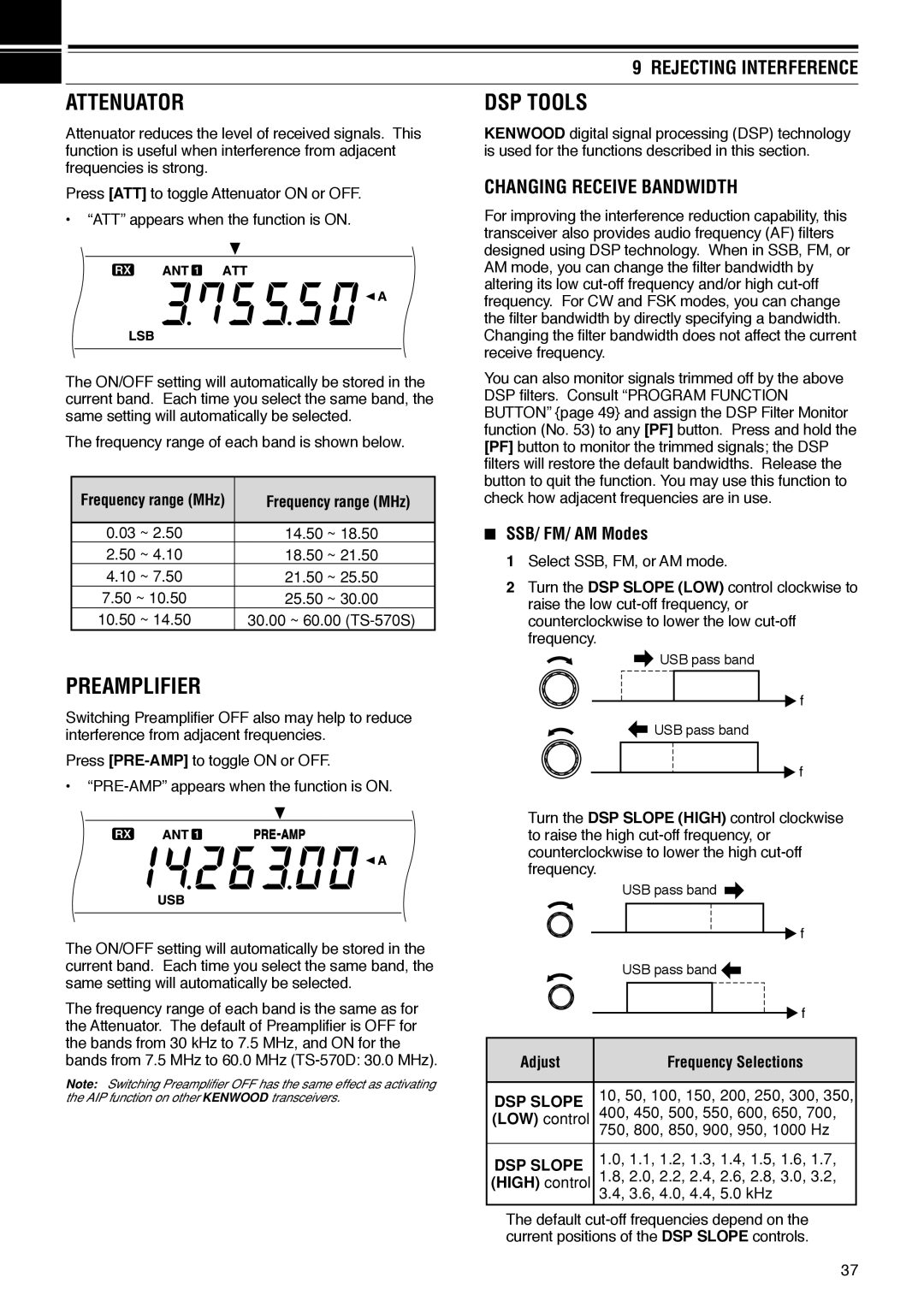
9 REJECTING INTERFERENCE
ATTENUATOR
Attenuator reduces the level of received signals. This function is useful when interference from adjacent frequencies is strong.
Press [ATT] to toggle Attenuator ON or OFF.
•“ATT” appears when the function is ON.
The ON/OFF setting will automatically be stored in the current band. Each time you select the same band, the same setting will automatically be selected.
The frequency range of each band is shown below.
Frequency range (MHz) | Frequency range (MHz) | |
|
|
|
0.03 | ~ 2.50 | 14.50 ~ 18.50 |
2.50 | ~ 4.10 | 18.50 ~ 21.50 |
4.10 | ~ 7.50 | 21.50 ~ 25.50 |
7.50 ~ 10.50 | 25.50 ~ 30.00 | |
10.50 | ~ 14.50 | 30.00 ~ 60.00 |
PREAMPLIFIER
Switching Preamplifier OFF also may help to reduce interference from adjacent frequencies.
Press
•
The ON/OFF setting will automatically be stored in the current band. Each time you select the same band, the same setting will automatically be selected.
The frequency range of each band is the same as for the Attenuator. The default of Preamplifier is OFF for the bands from 30 kHz to 7.5 MHz, and ON for the bands from 7.5 MHz to 60.0 MHz
Note: Switching Preamplifier OFF has the same effect as activating the AIP function on other KENWOOD transceivers.
DSP TOOLS
KENWOOD digital signal processing (DSP) technology is used for the functions described in this section.
CHANGING RECEIVE BANDWIDTH
For improving the interference reduction capability, this transceiver also provides audio frequency (AF) filters designed using DSP technology. When in SSB, FM, or AM mode, you can change the filter bandwidth by altering its low
You can also monitor signals trimmed off by the above DSP filters. Consult “PROGRAM FUNCTION BUTTON” {page 49} and assign the DSP Filter Monitor function (No. 53) to any [PF] button. Press and hold the [PF] button to monitor the trimmed signals; the DSP filters will restore the default bandwidths. Release the button to quit the function. You may use this function to check how adjacent frequencies are in use.
■SSB/ FM/ AM Modes
1 Select SSB, FM, or AM mode.
2Turn the DSP SLOPE (LOW) control clockwise to raise the low
![]() USB pass band
USB pass band
![]() f
f
![]() USB pass band
USB pass band
![]() f
f
Turn the DSP SLOPE (HIGH) control clockwise to raise the high
| USB pass band |
| f |
| USB pass band |
| f |
Adjust | Frequency Selections |
DSP SLOPE | 10, 50, 100, 150, 200, 250, 300, 350, |
(LOW) control | 400, 450, 500, 550, 600, 650, 700, |
| 750, 800, 850, 900, 950, 1000 Hz |
DSP SLOPE | 1.0, 1.1, 1.2, 1.3, 1.4, 1.5, 1.6, 1.7, |
(HIGH) control | 1.8, 2.0, 2.2, 2.4, 2.6, 2.8, 3.0, 3.2, |
| 3.4, 3.6, 4.0, 4.4, 5.0 kHz |
The default
37
